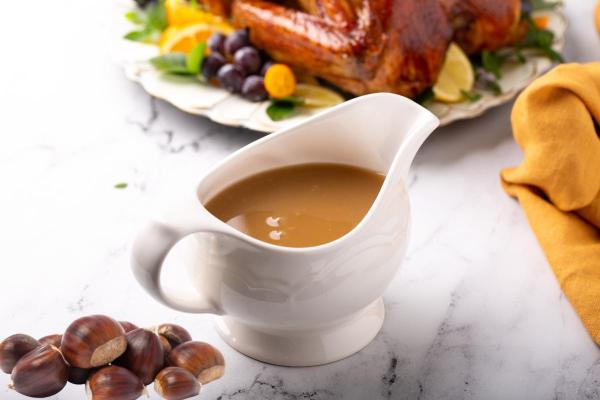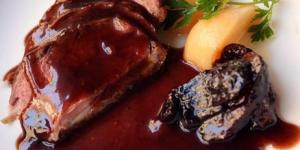How to Make Chestnut Sauce


Chestnuts are synonymous with winter and fall. They are naturally sweet, but their deep nuttiness makes them ideal for savory dishes. This means they can be eaten directly as a side, but they are also wonderful when roasted with certain types of veg. In fact, roasting really brings out their natural flavors. If you want to have a little chestnut flavor with everything, you can't go wrong with the best chestnut gravy recipe you can find. This is what oneHOWTO brings to you as we find out how to make chestnut sauce.
Ingredients:
Steps to follow:
If you're using fresh chestnuts, make a small cut in the skin with a sharp knife and boil them in water with a pinch of salt for 15-20 minutes. Carefully peel them while they're still hot, removing both the hard shell and the thin inner skin. If you're using pre-cooked chestnuts, simply drain and rinse them before using. Roasting will really bring out the flavor of chestnuts, but it is also time consuming.

Finely chop the shallot and garlic cloves, removing any green shoots if you find them to ensure the flavor is not too acrid.

Heat the butter and olive oil in a skillet over medium heat.

Add the shallot and garlic and fry for 3-5 minutes until soft and lightly browned. Be careful to keep the heat to medium so that the butter doesn't burn, but rather coats the ingredients evenly.

Add the peeled chestnuts to the pan and mix well so that they are coated with the sauce. If you wish, add a sprig of thyme to add a more aromatic touch.

Sprinkle over the flour so that it mixes with the fat in the pan. Cook until the raw flour smell goes away and all the ingredients are well covered.
Pour the hot stock into the pan slowly and stir while doing so. This will better help the chestnut gravy to incorporate. You can also better control the consistency. Add more stock if you want it to be thinner and less if you want it thicker. When it starts to bubble, reduce the heat and allow the mixture to simmer for 15-20 minutes. This will allow the chestnuts to soften further and absorb the flavors of the stock.

Remove the thyme sprig (if used) and transfer the mixture to a blender or use a hand mixer to puree until smooth.
Return the sauce to the pan and add the cream. Mix well and heat over low heat, without letting it boil. Adjust the salt and pepper to taste and, if you like, add a pinch of nutmeg for an aromatic touch.
If the sauce is too thick, you can add a little more broth until it reaches the desired consistency. If it is too thin, cook it for a few more minutes on low heat to thicken it.
Remove from heat and serve the chestnut sauce warm as an accompaniment to roasted meats, poultry or vegetables. You can also use this as a base for various dishes, enjoying it with potatoes, pasta, rice or pretty much whatever you like. It goes particularly well with roast chicken and lighter meat flavors. You can even use it as an alternative for this KFC mashed potatoes and gravy recipe.
If you really love this nut, you might want to have this chestnut sauce with some of these chestnut recipes for fall.

If you want to read similar articles to How to Make Chestnut Sauce, we recommend you visit our Recipes category.
Tips
- Use quality chestnuts: if you have access to fresh chestnuts, the flavor will be more intense and authentic. Packaged chestnuts are a good alternative to save time.
- Add a splash of wine: a splash of dry white wine or brandy while cooking the broth will intensify the flavor of the sauce.
- Try fresh herbs: in addition to thyme, you can experiment with rosemary or sage to add different aromatic nuances. They are also ideal for this time of year.
- Control the texture: blend the chestnuts to your preference, leaving small chunks for a more rustic sauce or blend completely for an ultra-smooth finish.
- Adjust the creaminess: if you're looking for a lighter sauce, replace the cream with evaporated milk or even a little plain yogurt.
- Customize with spices: in addition to nutmeg, try a pinch of cinnamon or ground cloves for a spicy autumnal touch.
- Make it ahead of time: chestnut sauce keeps well in the refrigerator for 2-3 days. It even improves in flavor after sitting overnight as the flavors settle and enrich.
- Gentle reheating: if you need to reheat the sauce, do so over low heat and add a little broth or cream to prevent it from drying out on the bottom of the pan. Don't boil or it might curdle.
- Ideal accompaniments: this sauce pairs wonderfully with pork, turkey, chicken or duck. It is also delicious over roasted squash or steamed broccoli.
- Elegant presentation: garnish with a few fresh thyme leaves or a drizzle of extra virgin olive oil before serving for a more professional finish.











